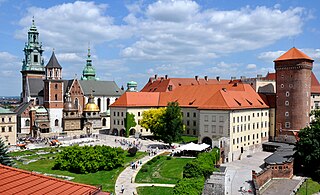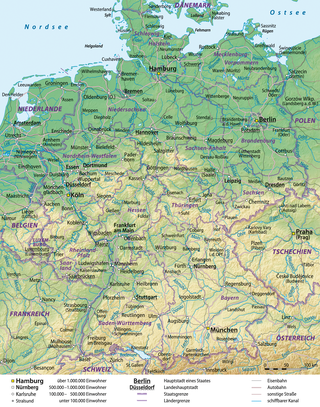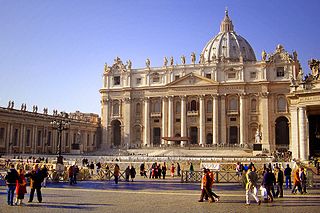
Tourism is travel for pleasure, and the commercial activity of providing and supporting such travel. The World Tourism Organization defines tourism more generally, in terms which go "beyond the common perception of tourism as being limited to holiday activity only", as people "travelling to and staying in places outside their usual environment for not more than one consecutive year for leisure and not less than 24 hours, business and other purposes". Tourism can be domestic or international, and international tourism has both incoming and outgoing implications on a country's balance of payments.

A tourist attraction is a place of interest that tourists visit, typically for its inherent or an exhibited natural or cultural value, historical significance, natural or built beauty, offering leisure and amusement.

Poland is a part of the global tourism market with constantly increasing number of visitors. Tourism in Poland contributes to the country's overall economy. The most popular cities are Kraków, Warsaw, Wrocław, Gdańsk, Poznań, Szczecin, Lublin, Toruń, Zakopane, the Salt Mine in Wieliczka and the historic site of Auschwitz – a German Nazi concentration camp in Oświęcim. The best recreational destinations include Poland's Masurian Lake District, Baltic Sea coast, Tatra Mountains, Sudetes and Białowieża Forest. Poland's main tourist offers consist of sightseeing within cities, historical monuments, natural monuments, business trips, agrotourism, bicycle touring, qualified tourism, mountain hiking (trekking) and climbing among others.

A resort is a self-contained commercial establishment that tries to provide most of a vacationer's wants, such as food, drink, swimming, accommodation, sports, entertainment and shopping, on the premises. A hotel is frequently a central feature of a resort and the term resort may be used for a hotel that provides an array of entertainment and recreational activities. Some resorts are also condominium complexes that are timeshares or owned fractionally or wholly owned condominium. A resort is not always a commercial establishment operated by a single company, but in the late 20th century, that sort of facility became more common.

Germany is the eighth-most-visited country in the world, with a total of 407.26 million overnights during 2012. This number includes 68.83 million nights by foreign visitors, the majority of foreign tourists in 2009 coming from the Netherlands, the United Kingdom, and Switzerland. Additionally, more than 30% of Germans spend their holiday in their own country. According to Travel and Tourism Competitiveness Reports, Germany is ranked 3 out of 136 countries in the 2017 report, and is rated as one of the safest travel destinations worldwide.

A visitor center or centre, visitor information center or tourist information centre is a physical location that provides information to tourists.

Tourism in the United Kingdom is a major industry and contributor to the U.K. economy, which is the world's 10th biggest tourist destination, with over 40.1 million visiting in 2019, contributing a total of £234 billion to the GDP.

Tourism is a significant industry in the state of Victoria, Australia. The country's second most-populous city, Melbourne was visited by 2.7 million international overnight visitors and 9.3 million domestic overnight visitors during the year ending December 2017.

Tourism is an important sector for the Philippine economy. The travel and tourism industry contributed 6.2% to the country's GDP in 2022; this was lower than the 12.7% recorded in 2019 prior to the COVID-19 lockdowns. Coastal tourism, encompassing beach and diving activities, constitutes 25% of the Philippines' tourism revenue, serving as its primary income source in the sector. Popular destinations among tourists include Boracay, Palawan, Cebu and Siargao. While the Philippines has encountered political and social challenges that have affected its tourism industry, the country has also taken steps to address these issues. Over the past years, there have been efforts to improve political stability, enhance security measures, and promote social inclusivity, all of which contribute to creating a more favorable environment for tourism, such as the Boracay rehabilitation.

The tourism industry in South Korea caters to both foreign and domestic tourists. In 2012, 11.1 million foreign tourists visited South Korea, making it the 20th most visited country in the world, and the 5th most visited in Asia. Most non-Korean tourists come from other parts of East Asia such as Japan, mainland China, Taiwan, and Hong Kong. The recent popularity of Korean popular culture, often known as the "Korean Wave", in these countries has increased tourist arrivals. Seoul is the principal tourist destination for visitors; popular tourist destinations outside of Seoul include the major coastal city of Busan, the Seorak-san national park, the historic city of Gyeongju and subtropical Jeju Island.

London, the capital city of England, is one of the world's most visited cities in terms of international visits. It is home to an array of notable tourist attractions, attracting 20.42 million international visitors in 2018, an additional 27.8 million overnighting domestic tourists in 2017, and 280 million day-trippers in 2015.

Tourism in Gibraltar constitutes one of the British Overseas Territory's most important economic pillars, alongside financial services and shipping. Gibraltar's main attractions are the Rock of Gibraltar and its resident population of Barbary macaques, the territory's military heritage, duty-free shopping, casinos and marinas. Although the population of Gibraltar numbers only some 30,000 people, the territory recorded nearly 12 million visits in 2011, giving it one of the highest tourist-to-resident ratios in the world.

Christian tourism is a subcategory of religious tourism which is geared towards Christians. As one of the largest branches of religious tourism, it is estimated that seven percent of the world's Christians—about 168 million people—are "on the move as pilgrims" each year.

Leeds in West Yorkshire, England is a tourist destination.

Tourism in Morocco is well developed, maintaining a strong tourist industry focused on the country's coast, culture, and history. The Moroccan government created a Ministry of Tourism in 1985. Tourism is considered one of the main foreign exchange sources in Morocco and since 2013 it had the highest number of arrivals out of the countries in Africa. In 2018, 12.3 million tourists were reported to have visited Morocco.
Bangkok, the capital of Thailand, is one of the world's top tourist destination cities. Each year, approximately 22.7 million international visitors arrive in Bangkok. MasterCard ranked Bangkok as the world's top destination city, with 15.98 million projected visitors in 2013. It topped the MasterCard Global Destinations Cities Index as the most visited city in the world in 2012, 2013, 2016, 2017 and 2018. The city is ranked fourth in cross-border spending, with 14.3 billion dollars projected for 2013, after New York, London and Paris. Euromonitor International ranked Bangkok sixth in its Top City Destinations Ranking for 2011. Bangkok has also been named "World's Best City" by Travel + Leisure magazine's survey of its readers for four consecutive years since 2010.

Tourism in Yorkshire generates more than £9 billion per annum and supporting almost 225,000 jobs. During 2007 recorded 92 million day visitors and 12.8 million that stayed at least one night in the region. By 2015, the value of tourism was in excess of £7 billion. Yorkshire is around 6,000 square miles (16,000 km2) in size. The official tourism body for the region was Welcome to Yorkshire until it became insolvent in 2022. As of December 2023, Local Visitor Economy Partnerships to manage tourism have been announced for Hull and East Yorkshire, York and North Yorkshire, and West Yorkshire.

Icy Strait Point is a privately owned tourist destination just outside the small village of Hoonah, Alaska. It is located on Chichagof Island and is named after the nearby Icy Strait. Owned by Huna Totem Corporation, it is the only privately owned cruise destination in Alaska, as most stops are owned by the cities in which they are located. Huna Totem Corporation is owned by approximately 1,350 Alaskan Natives with aboriginal ties to Hoonah and the Glacier Bay area. Many of them are of the Tlingit people.

The following outline is provided as an overview of and topical guide to tourism:
Tourism was limited to the upper-class of ancient Rome due to its expense. Travel was also difficult because of shipwrecks, storms, poor maps, and a lack of modern means of transport. Tourism was difficult due to the time required to travel long distances in ancient Rome. Common destinations for ancient Roman tourists were Greece, Egypt, and the coast of Campania. Wealthy Romans would also spend the hottest parts of the year in villas outside of the city of Rome or in resort towns such as Baiae. These trips usually boosted the local economy as the locals attempted to supply the tourists with housing, goods, and services.

















